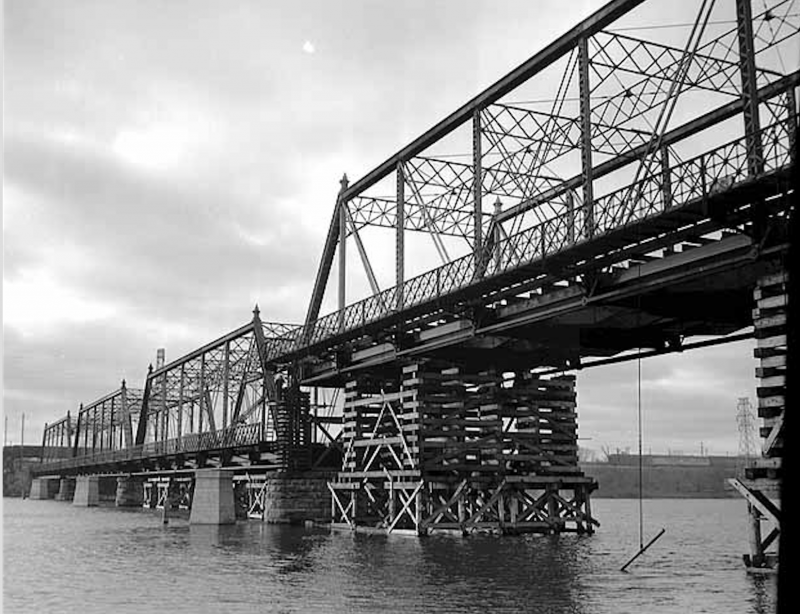
Recently while running errands, I managed to cross all four of North Minneapolis’ bridges. It got me thinking about how we all cross the Mississippi River over these bridges without ever thinking about their history and thought folks might want to know a bit of that history.
Plymouth Bridge
The first permanent North Minneapolis bridge was the one at Plymouth Ave. The original bridge was a wooden Howe truss design, built in 1873. It was built when the city of Minneapolis, on the west side of the Mississippi River, consolidated with the city of St. Anthony, on the east side of the river. When the two merged, Minneapolis agreed to build two bridges, one upstream of the Hennepin Ave Bridge and one downstream. That first bridge was replaced in 1886 with an iron truss Camelback bridge. In 1953 the bridge was raised to allow more clearance for river navigation. In 1981, because the floor beams were deteriorated by corrosion over the years, the bridge was closed. The current segmental bridge was built in 1983. The bridge closed in October 2010 “as a precaution” because of discovered corrosion on cables that ran through the bridge. It opened to pedestrian and bike traffic in January 2011 but didn’t reopen to vehicle traffic until August 2013, when after several delays, the corroded cables could be replaced.
Broadway Bridge
The first bridge was a wooden structure completed in 1857, but washed away in a flood in 1859. It wouldn’t be until 1887 that a permanent second bridge was built. The bridge was a four-span Pratt truss bridge and was quite ornate, each bridge segment featured finials on each top corner with a band of scrolls, crosses and lines between them. In 1950 the bridge was raised 20 feet so that barges and larger boats could pass underneath it. Almost 100 years later in 1985, the bridge was removed. However, a single span of the 1887 bridge lives on as the Merriam Street Bridge that connects Nicollet Island to the St. Anthony section of Minneapolis. The current Broadway Bridge is a girder bridge that was built in 1987.
Lowry Bridge
The original camelback style bridge was built in 1905 as a five-span truss bridge design. This bridge lasted 51 years until it became too weak to carry traffic. Five new truss spans were built in 1958, using the same piers, but raised 20 feet to allow navigation on the upper Mississippi River. This new 1958 bridge was notable because it had a steel grid deck which meant that the river was visible directly through the mesh. The bridge was closed at times during 2003 and 2004 to replace the steel grid deck and to repaint the bridge. In 2004, it was also discovered that the pier 3 bearings (east side of navigation channel) had moved roughly 11 inches east of their original location. On April 25, 2008 Hennepin County closed the bridge due to safety concerns. It would be more than a year later on June 21, 2009 that the bridge would be imploded. The steel grate decking was removed before the implosion and now lives on as part of the fencing around the Minneapolis Public Works facility at 26th and Hiawatha Aves. Construction of a replacement bridge began in early 2010 and on October 27, 2012, the new steel tied-arch, basket handle design bridge, opened to traffic.
Camden Bridge
The original Camden Bridge was built in 1913. Up until that time, there was no way to cross the Mississippi River between the Lowry Bridge and the Champlin-Anoka Bridge. This bridge, like both the original Plymouth and Lowry bridges, was a steel truss camelback bridge. It connected 42nd Ave N and 37th Ave NE as well as St. Anthony Blvd. The bridge closed on August 9, 1973. The bridge, which was carrying about 12,000 vehicles daily, had been limited to three-ton loads since 1969. In 1975 or 1976 the bridge was demolished with a combination of dynamite and a crane and metal ball. The current blue span plate girder bridge was built in 1977.
** On the Camden Community Historical Society FaceBook page there is a video of the old Lowry Bridge being imploded.


